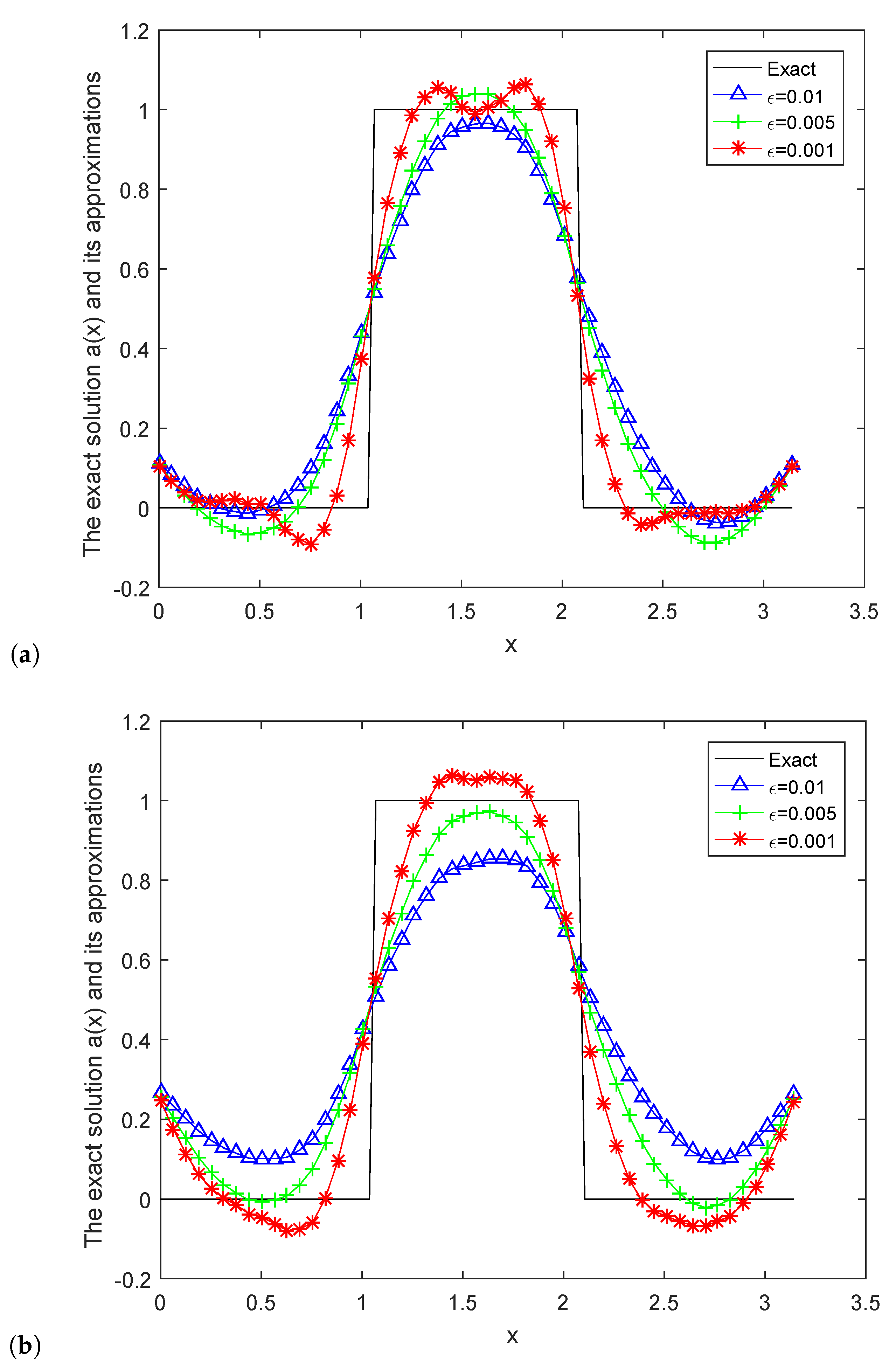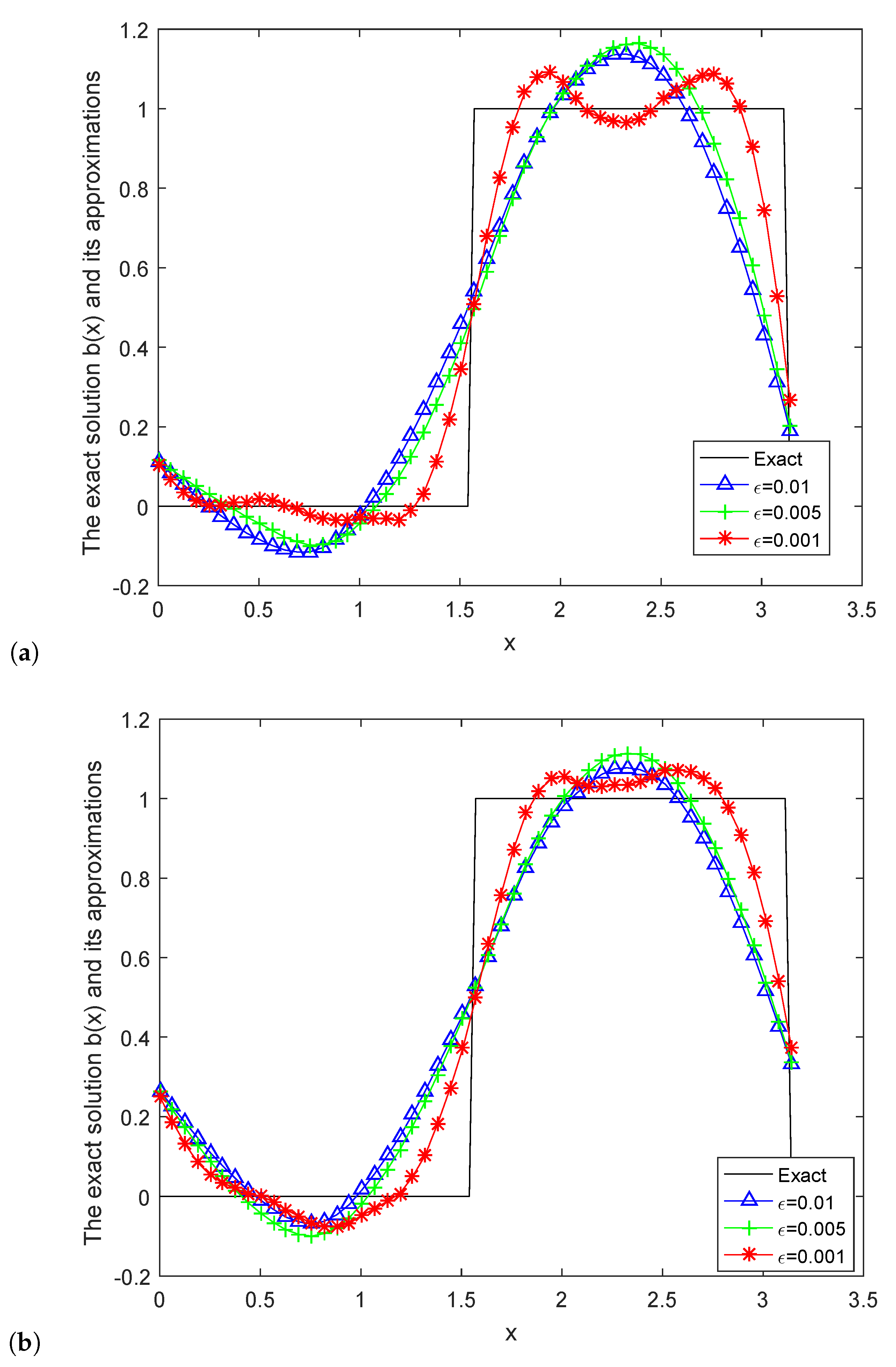The Truncation Regularization Method for Identifying the Initial Value on Non-Homogeneous Time-Fractional Diffusion-Wave Equations
Abstract
:1. Summary
2. Some Auxiliary Results
3. Exact Solution and Conditional Stability
4. Regular Solutions and Error Estimations
- (a)
- is a successive function;
- (b)
- (c)
- (d)
- is a strictly decreasing function.
5. Numerical Implementation
6. Conclusions
Author Contributions
Funding
Conflicts of Interest
References
- Metzler, R.; Klafter, J. The random walk’s guide to anomalous diffusion: A fractional dynamics approach. Phys. Rep. 2000, 339, 1–77. [Google Scholar] [CrossRef]
- Othman, M.I.A.; Marin, M. Effect of Thermal Loading due to Laser Pulse on Thermoelastic Porous Medium under G-N Theory. Results Phys. 2017, 7, 3863–3872. [Google Scholar] [CrossRef]
- Chang, F.X.; Chen, J.; Huang, W. Anomalous diffusion and fractional advection diffusion equation. Acta Physica Sinica Chin. Ed. 2005, 54, 1113–1117. [Google Scholar]
- Gu, Q.; Schiff, E.A.; Grebner, S.; Wang, F.; Schwarz, R. Non-Gaussian transport measurements and the Einstein relation in amorphous silicon. Phys. Rev. Lett. 1996, 76, 3196–3199. [Google Scholar] [CrossRef]
- Klammler, F.; Kimmich, R. Geometrical restrictions of incoherent transport of water by diffusion in protein of silica fineparticle systems and by flow in a sponge—A study of anomalous properties using an NMR field-gradient technique. Croat. Chem. Acta 1992, 65, 455–470. [Google Scholar]
- Weber, H.W.; Kimmich, R. Anomalous segment diffusion in polymers and NMR relaxation spectroscopy. Macromolecules 1993, 26, 2597–2606. [Google Scholar] [CrossRef]
- Klemm, A.; Muller, H.P.; Kimmich, R. NMR microscopy of pore-space backbones in rock, sponge, and sand in comparison with random percolation model objects. Phys. Rev. E 1997, 55, 4413–4422. [Google Scholar] [CrossRef]
- Porto, M.; Bunde, A.; Havlin, S.; Roman, H.E. Structural and dynamical properties of the percolation backbone in two and three dimensions. Phys. Rev. E 1997, 56, 1667–1675. [Google Scholar] [CrossRef] [Green Version]
- Weeks, E.R.; Swinney, H.L. Anomalous diffusion resulting from strongly asymmetric random walks. Phys. Rev. E 1998, 57, 4915–4920. [Google Scholar] [CrossRef] [Green Version]
- Luedtke, W.D.; Landman, U. Slip diffusion and Levy flights of an adsorbed gold nano-cluster. Phys. Rev. Lett. 1999, 82, 3835–3838. [Google Scholar] [CrossRef]
- McLean, W.; Mustapha, K. A second-order accurate numerical method for a fractional wave equation. Numer. Math. 2007, 105, 481–510. [Google Scholar] [CrossRef]
- Shlesinger, M.F.; West, B.J.; Klafter, J. Levy dynamics of enhanced diffusion: Application to turbulence. Phys. Rev. Lett. 1987, 58, 1100–1103. [Google Scholar] [CrossRef] [PubMed]
- Schaufler, S.; Schleich, W.P.; Yakovlev, V.P. Scaling and asymptotic laws in subrecoil laser cooling. Europhys. Lett. 1997, 39, 383–388. [Google Scholar] [CrossRef]
- Zumofen, G.; Klafter, J. Spectral random walk of a single molecule. Chem. Phys. Lett. 1994, 219, 303–309. [Google Scholar] [CrossRef]
- Bychuk, O.V.; O’Shaughnessy, B. Anomalous diffusion at liquid surfaces. Phys. Rev. Lett. 1995, 74, 1795–1798. [Google Scholar] [CrossRef]
- Nigmatullin, R.R. To the theoretical explanation of the “universal response”. Phys. Status Solidi 1984, 123, 739–745. [Google Scholar] [CrossRef]
- Nigmatullin, R.R. The realization of the generalized transfer equation in a medium with fractal geometry. Physica Status Solidi 1986, 133, 425–430. [Google Scholar] [CrossRef]
- Balescu, R. V-Langevin equations, continuous time random walks and fractional diffusion. Chaos Soliton. Fract. 2007, 34, 62–80. [Google Scholar] [CrossRef] [Green Version]
- Sakamoto, K.; Yamamoto, M. Initial value/boundary value problems for fractional diffusion-wave equations and applications to some inverse problems. J. Math. Anal. Appl. 2011, 382, 426–447. [Google Scholar] [CrossRef] [Green Version]
- Šišková, K.; Slodička, M. Identification of a source in a fractional wave equation from a boundary measurement. J. Math. Anal. Appl. 2019, 349, 172–186. [Google Scholar] [CrossRef]
- Šišková, K.; Slodička, M. Recognition of a time-dependent source in a time-fractional wave equation. Appl. Numer. Math. 2017, 121, 1–17. [Google Scholar] [CrossRef]
- Wei, T.; Zhang, Y. The backward problem for a time-fractional diffusion-wave equation in a bounded domain. Comput. Math. Appl. 2018, 75, 3632–3648. [Google Scholar] [CrossRef]
- Yang, F.; Zhang, Y.; Li, X.X. Landweber iterative method for identifying the initial value problem of the time-space fractional diffusion-wave equation. Numer. Algorithms 2019, 2019. [Google Scholar] [CrossRef]
- Yang, F.; Wang, N.; Li, X.X.; Huang, C.Y. A quasi-boundary regularization method for identifying the initial value of time-fractional diffusion equation on spherically symmetric domain. J. Inverse Ill Posed Probl. 2019. [Google Scholar] [CrossRef]
- Yang, F.; Sun, Y.R.; Li, X.X.; Huang, C.Y. The quasi-boundary value method for identifying the initial value of heat equation on a columnar symmetric domain. Numer. Algorithms 2019, 82, 623–639. [Google Scholar] [CrossRef]
- Yang, F.; Fan, P.; Li, X.X. Fourier Truncation Regularization Method for a Three-Dimensional Cauchy Problem of the Modified Helmholtz Equation with Perturbed Wave Number. Mathematics 2019, 7, 705. [Google Scholar] [CrossRef]
- Yang, F.; Fan, P.; Li, X.X.; Ma, X.Y. Fourier Truncation Regularization Method for a Time-Fractional Backward Diffusion Problem with a non-linear Source. Mathematics 2019, 7, 865. [Google Scholar] [CrossRef]
- Yang, F.; Zhang, P.; Li, X.X. The truncation method for the Cauchy problem of the inhomogeneous Helmholtz equation. Appl. Anal. 2019, 98, 991–1004. [Google Scholar] [CrossRef]
- Yang, F.; Ren, Y.P.; Li, X.X. The quasi-reversibility method for a final value problem of the time-fractional diffusion equation with inhomogeneous source. Math. Method. Appl. Sci. 2018, 41, 1774–1795. [Google Scholar] [CrossRef]
- Sun, Z. The Method of Order Reduction and Its Application to the Numerical Solutions of Partial Differential Equation; SECI Press: Beijing, China, 2009. [Google Scholar]







| 1.1 | 1.3 | 1.5 | 1.7 | 1.9 | |
| 0.0599 | 0.0935 | 0.1406 | 0.5209 | 1.0032 |
© 2019 by the authors. Licensee MDPI, Basel, Switzerland. This article is an open access article distributed under the terms and conditions of the Creative Commons Attribution (CC BY) license (http://creativecommons.org/licenses/by/4.0/).
Share and Cite
Yang, F.; Pu, Q.; Li, X.-X.; Li, D.-G. The Truncation Regularization Method for Identifying the Initial Value on Non-Homogeneous Time-Fractional Diffusion-Wave Equations. Mathematics 2019, 7, 1007. https://doi.org/10.3390/math7111007
Yang F, Pu Q, Li X-X, Li D-G. The Truncation Regularization Method for Identifying the Initial Value on Non-Homogeneous Time-Fractional Diffusion-Wave Equations. Mathematics. 2019; 7(11):1007. https://doi.org/10.3390/math7111007
Chicago/Turabian StyleYang, Fan, Qu Pu, Xiao-Xiao Li, and Dun-Gang Li. 2019. "The Truncation Regularization Method for Identifying the Initial Value on Non-Homogeneous Time-Fractional Diffusion-Wave Equations" Mathematics 7, no. 11: 1007. https://doi.org/10.3390/math7111007




